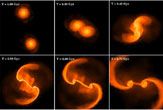Super Black Holes Traced to Collisions of Earliest Galaxies

The monster black holes at the heart of galaxies may have originated from galaxy collisions during the earliest period of universe, new supercomputer models suggest.
Supermassive black holes — millions to billions of times the mass of our sun — are thought to reside at the center of almost every galaxy. Astronomers have found the presence of supermassive black holes within the first billion years of the universe, meaning they took much less time to form than current ideas suggest.
Now calculations on supercomputers suggest that mergers between massive protogalaxies of the early universe provided a breeding ground for supermassive black holes, each one forming over only 100 million years or so. Scientists estimate the universe is 13.7 billion years old. [Black Holes of the Universe]
Mergers between giant primordial galaxies are thought to have been common in the early universe. Simulations run on supercomputers suggest that a merger could have formed an unstable, rotating disk of gas, which funneled gas amounting to more than a 100 million times the mass of the sun into a small cloud in only 100,000 years. This cloud collapsed to give birth to a black hole, which could then grow to a billion solar masses in about 100 million years by sucking gas from the surrounding disk.
Previously, astronomers had suggested supermassive black holes, galaxies and other giant cosmic structures had formed gradually as gravity drew small bits of matter together into larger and larger clumps.
"Our result shows that big structures, both galaxies and massive black holes, build up quickly in the history of the universe," said study co-author Stelios Kazantzidis, an astronomer at Ohio State University.
The implications of this new discovery are far-reaching in our understanding of the evolution of the black holes and galaxies, Kazantzidis said.
Sign up for the Live Science daily newsletter now
Get the world’s most fascinating discoveries delivered straight to your inbox.
"For example, the standard idea that a galaxy's properties and the mass of its central black hole are related because the two grow in parallel will have to be revised," Kazantzidis explained. "In our model, the black hole grows much faster than the galaxy. So it could be that the black hole is not regulated at all by the growth of the galaxy. It could be that the galaxy is regulated by the growth of the black hole."
One important consequence of this model is that galaxies in the very early universe should have much bigger central supermassive black holes than expected, said the study's lead author, Lucio Mayer, an astrophysicist at the University of Zurich in Switzerland. In comparison, galaxies nowadays generally have central black holes appropriate for their size.
A number of instruments coming online in the next five to 10 years, such as the James Webb Space Telescope and the Atacama Large Millimeter Array (ALMA), are expected to be able to measure the masses of these early galaxies and their central black holes to prove or disprove this model. "Possibly new data from lots of other instruments might be able to provide an answer even earlier," Mayer told SPACE.com.
These new findings also could help astronomers better uncover enigmatic gravitational waves.
According to Einstein’s theory of general relativity, ancient galaxy mergers would have created massive gravitational waves — ripples in the very fabric of space and time whose remnants should still be detectable today.
New gravitational wave detectors, such as NASA's Laser Interferometer Space Antenna, were designed to spot these waves directly, opening a window into the workings of our cosmos. To interpret the results from these detectors, however, scientists will need to know how supermassive black holes formed. The new computer simulations should provide a clue, the researchers noted.
The scientists detailed their findings Aug. 26 in the journal Nature.













